Holbein embroidery is a special case of Spanish blackwork, so popular in the 15th and 16th centuries. The name is sometimes used interchangeably with “blackwork”. I've taken the position that, as I use the term “Holbein embroidery”, it differs from the traditional blackwork or redwork in two ways: it is done in multicolor, rather than solid black or red, and it can be done on canvas as well as fabric. (Blackwork and redwork are traditionally done on linen, but that's a “rule” I break — a lot!) Besides, I find “Holbein embroidery” a term less confusing than “blackwork done in color”. Our purpose here is to bring these Renaissance techniques into the 21st Century to use on contemporary projects. For example, here are my “Onion Domes” done both in blackwork and in Holbein embroidery. I seldom do the same design more than once — and never in the exact same way — but it seemed worthwhile to repeat this one in order to let you compare and contrast the two techniques.
 |
| Annake's "Onion Domes" and "Colorful Onion Domes" |
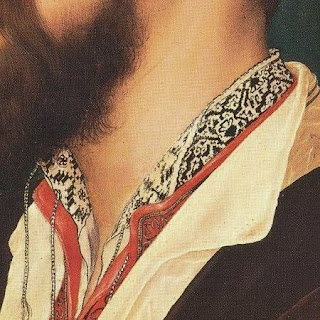 |
| Detail of blackwork from painting by Holbein the Younger |
The Holbein style of needlework is named in honor of Hans Holbein the Younger, a Dutch artist who was the official court painter for King Henry VIII of England from 1537 to 1543, and who painted detailed renderings of the fancy embroidered clothing of that era. The Holbein stitch is a double-running stitch used widely in Holbein embroidery. Its virtue is that it covers both sides of the fabric. When it is done skillfully, there is no “right” or “wrong” side to the piece. Once a couple of lines of Holbein stitches are laid in parallel to each other, they can be whipped, couched, threaded. laced, back-stitched, interlaced, made into Pekinese stitch, etc. (For more on these techniques, see
our recent post about crewel embroidery.)
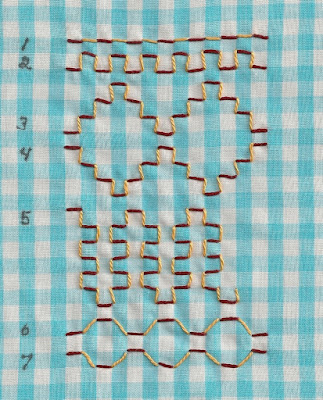 |
| Holbein stitch sampler, black and gold on blue gingham |
Holbein stitch is made up of evenly-spaced running stitches worked in one direction, then worked in the reverse direction to fill the spaces between the stitches, using the same needle holes that were used the first time. The running stitches may be horizontal, vertical, or diagonal. I've tried to simplify the process by stitching on checked gingham so the stitches are of uniform lengths, and by using different colors for the forward and backward stitches. Traditionally, the first stitches go from right to left. If you are left-handed, however, you may find it easier to work from left to right. You can turn your fabric at the end of each stitch row if you like, so that you are always stitching in the same direction. Check your practice work from time to time to see that the stitches are uniform on both sides of the fabric. This takes some practice, especially to avoid splitting stitches. On the stitch sampler we have: 1) double-running stitch, 2) a Greek Key design, 3) a stepped design, 4) the stepped design reversed, 5) a design using Holbein stitch vertically, 6) a pattern with diagonal stitches and 7) the last stitch pattern reversed. Combine 3 and 4 to get a border with plenty of space for another design in cross-stitch, star stitch, lazy daisy, etc., inside each outlined space. Combining 6 and 7 gives you a smaller border, but still has room for an extra motif inside. Holbein embroidery uses the same filling designs and diaper patterns that we have used for blackwork, as well as more elaborate leaf, flower, fruit and insect designs.
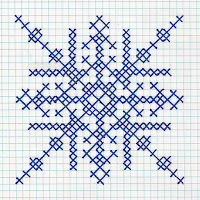 |
| Snowflake cross-stitch pattern |
These patterns are very versatile. In fact, here is that kind of design as the basis for counted cross-stitch! Can you see how you can adapt patterns from one kind of needlework to another? The pattern could just as easily be done in tent stitch or even latch-hook.
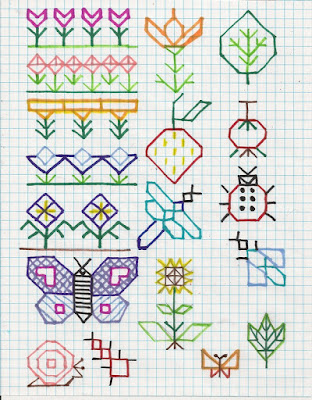 |
| Holbein embroidery design 'doodles' |
Here are some of the designs I've been playing around with as fillers or for use on small projects. If you like to “doodle” and make little drawings while you talk on the phone or wait at the doctor's office, you should try making small motifs of your own like these. The stylized flowers are easy. They can be used in closely arranged rows as filling in a design, in single rows as a border, or broken apart to scatter and repeat over a larger area (a diaper pattern). The little “bugs” were fun to do, as was the snail. Designing them is something enjoyable you can do with your children or grandchildren, too. Some of the larger separate designs are attractive additions to babies' or children's clothing. You can apply these by using a chart and counting threads, by making your own transfer patterns, or by embroidering through waste canvas — a removable needlepoint canvas that isn't interlocked. You pin or baste a piece of the waste canvas, somewhat larger then your design, loosely in the desired spot on the background. Embroider the design as you usually would, not pulling your stitches too tight. When the design is finished, gently pull out each of the canvas threads. I like to steam-press the embroidery afterward.
But you do not have to use the Holbein stitch if you don't want to do it. Just use the stitches the way you have been doing for blackwork, but do them in the colors you desire. We have shown you a way to "grow" a blackwork pattern using colors. I mentioned then that I use alternate colors when planning a complex blackwork pattern, so that I can do the changes in each new round exactly the same way all around.
Then we showed you the design done in rainbow colors. Now I am going to show you a new design using 3 colors alternately. I will show the first 10 steps. I have worked the design through four further steps, but I am not going to show those. Instead, I will challenge you to do the next 4 steps in any way you like. I'm pretty sure none of your final designs will be exactly like mine — or like each other's designs. (If you have friends who are interested, make it a competition.) Use as many colors of yarn or floss as you like, but make sure each step is in a different color than the one before it and the one after it, so you will need a minimum of 2 colors.
Here are some simple patterns that each give you the center ‘spot' or ‘cluster’ pattern for one of these developing designs.
Choose any one of them and draw it in color at the center of a sheet of graph paper. Then start at each side or each corner — or both — with a repeatable element in another color. Be sure you have done the same markings all the way around. Then change colors again and continue in the same way until the design is large enough to suit you. Once it is complete, reproduce it in yarn or floss on an even-weave fabric like checked gingham or monk's cloth. When you have finished, you should have something entirely unique. Doesn't that feel good?
Another way to use these small motifs is to arrange them in a straight line, either vertically or horizontally, in order to create a border design. If your border is to be used to frame something, be very careful that your corner motifs line up, with exactly the same spaces between them, both horizontally and vertically. Or you may want a different motif just for the four corner spaces. Be sure your corner motifs are similar enough in design to the motifs for the four sides that they don't overwhelm them. Notice the extra stitch pointing to the appropriate corner on this motif.
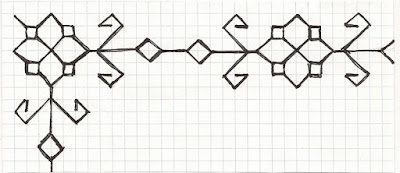 |
| Corner motif stitch pattern |
My intent is
not to give you designs to follow slavishly. My intent is to give you designs that teach you the basic stitch patterns and then — hopefully — encourage you to get enough out of your comfort zone to invent simple patterns of your own. From that stage, I would hope you'd continue until you were adapting patterns to make larger and more complex designs or to apply skills you have learned in one technique to something entirely different, like calligraphy or painting. Another desirable outcome, from my point of view, would be to use something you have learned in another craft — like decoupage or cake decorating, for example — and apply it to some form of needlework like trapunto or needle-weaving. I want you to come to see the tremendous possibilities inherent in these simple techniques. Look! Try! Do! Explore possibilities! Create!
YES, YOU CAN! I have confidence in you!






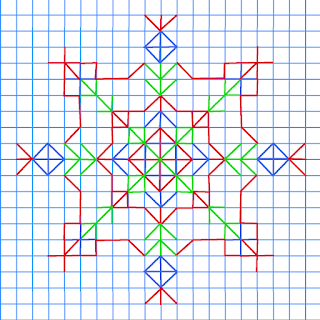

 This post by Annake's Garden is licensed under a Creative Commons Attribution-NonCommercial-ShareAlike 3.0 Unported License.
This post by Annake's Garden is licensed under a Creative Commons Attribution-NonCommercial-ShareAlike 3.0 Unported License.
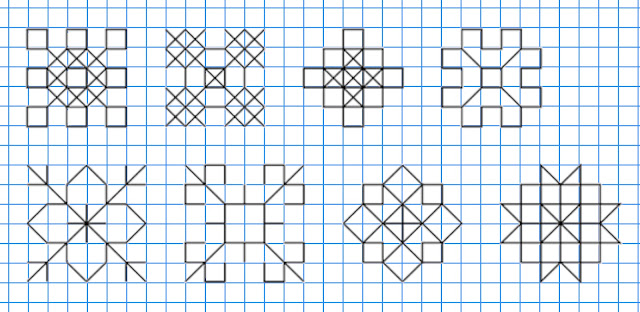
It's that time of the year when productivity plummets and "Cinderella" references hit an annual high. March Madness is upon us, so here's everything you need to know about the NCAA tournament. March Madness is Starts on March 13, 2022. Here is a complete guide to watch March Madness 2022 online from anywhere without cable. How to Watch March Madness 2022 Live from available at home.
ReplyDelete